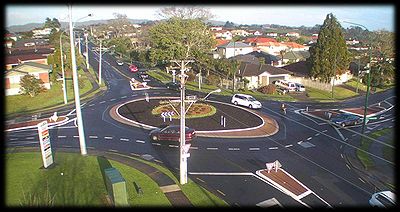Difference between revisions of "C-Roundabout"
The Duncan (talk | contribs) |
The Duncan (talk | contribs) |
||
| Line 3: | Line 3: | ||
[[File:Crbt1.jpg|400px|left]] | [[File:Crbt1.jpg|400px|left]] | ||
| − | The C-Roundabout is a new type of multi-lane roundabout developed in New Zealand in 2005, originally as means of more safely catering for on-road cyclists. It was developed by Duncan Campbell and Ivan Jurisich of Traffic Engineering Solutions Ltd [http://www.tes.net.nz/] as part of the New Zealand Transport Agency (NZTA) research programme [http://www.nzta.govt.nz/resources/research/reports/287/] [http://www.ipenz.org.nz/ipenztg/conf05/papers/5%20CAMPBELL.pdf][[Media:Crbtaustroads2006.pdf]], and was concurrently the topic for a thesis submitted for partial completion of a Masters degree (civil engineering) by Duncan Campbell. | + | The C-Roundabout is a new type of multi-lane roundabout developed in New Zealand in 2005, originally as means of more safely catering for on-road cyclists. It was developed by Duncan Campbell and Ivan Jurisich of Traffic Engineering Solutions Ltd [http://www.tes.net.nz/] as part of the New Zealand Transport Agency (NZTA) research programme [http://www.nzta.govt.nz/resources/research/reports/287/] [http://www.ipenz.org.nz/ipenztg/conf05/papers/5%20CAMPBELL.pdf][http://www.organicdesign.co.nz/files/3/33/Crbtaustroads2006.pdf] [[Media:Crbtaustroads2006.pdf]], and was concurrently the topic for a thesis submitted for partial completion of a Masters degree (civil engineering) by Duncan Campbell. |
Many cyclists find big roundabouts daunting to ride around, and can also suffer much higher crash rates than at traffic signals. Although multi-lane roundabouts are not necessarily death-traps for cyclists, they can be at the very least a deterrent to novice riders. The New Zealand government is trying to encourage more people take up cycling for both health and congestion-relief reasons, so this matter is of some concern. | Many cyclists find big roundabouts daunting to ride around, and can also suffer much higher crash rates than at traffic signals. Although multi-lane roundabouts are not necessarily death-traps for cyclists, they can be at the very least a deterrent to novice riders. The New Zealand government is trying to encourage more people take up cycling for both health and congestion-relief reasons, so this matter is of some concern. | ||
Revision as of 18:39, 10 November 2011
Author: Duncan Campbell The Duncan
The C-Roundabout is a new type of multi-lane roundabout developed in New Zealand in 2005, originally as means of more safely catering for on-road cyclists. It was developed by Duncan Campbell and Ivan Jurisich of Traffic Engineering Solutions Ltd [1] as part of the New Zealand Transport Agency (NZTA) research programme [2] [3][4] Media:Crbtaustroads2006.pdf, and was concurrently the topic for a thesis submitted for partial completion of a Masters degree (civil engineering) by Duncan Campbell.
Many cyclists find big roundabouts daunting to ride around, and can also suffer much higher crash rates than at traffic signals. Although multi-lane roundabouts are not necessarily death-traps for cyclists, they can be at the very least a deterrent to novice riders. The New Zealand government is trying to encourage more people take up cycling for both health and congestion-relief reasons, so this matter is of some concern.
Roundabouts are a much safer form of intersection control than traffic signals and will suffer far fewer injury crashes. This is simply because much higher collision speeds are possible at traffic signals compared to a well designed roundabout. However, many city councils in New Zealand are more concerned with catering for pedestrians and cyclists and are instead installing traffic signals which is contrary to the objective of reducing injury crashes on our roads. Other reasons may include: conventional multi-lane roundabouts can take up a lot of room so can be expensive to install; roundabouts are generally trickier things to design well; and traffic behaviour can be less predictable than at traffic signals. This is where the C-Roundabout fits in quite well - it can be built in a compact area (i.e. cheaper) and if designed with lower vehicle speeds in mind can be safer for both pedestrians as well as cyclists. This is achievable because it requires larger vehicles such as truck or buses to straddle traffic lanes, and car drivers have to discern that they are to keep clear of these vehicles.
Several C-Roundabouts have been successfully built in Waitakere City since 2007. A NZTA research project that reviewing their operation is currently being submitted for publication and hopefully should be available early 2011 [5], [6]. This review includes evaluation of vehicle speeds and road user behaviour and collecting feedback from drivers, cyclists and pedestrians. In general though a reasonably high proportion of car drivers do not like them because they squeeze you closer to vehicles in adjacent lanes. However cyclists and pedestrians certainly prefer the C-Roundabout because traffic speeds are lower and cyclists are better able to 'claim the lane'.
Note this page is at the moment in its very draft stages so my apologies. I hope to clean it up a bit and add more references, and put some links to video footage which I will try to make available. The Duncan 06:54, 10 September 2010 (NZST)








